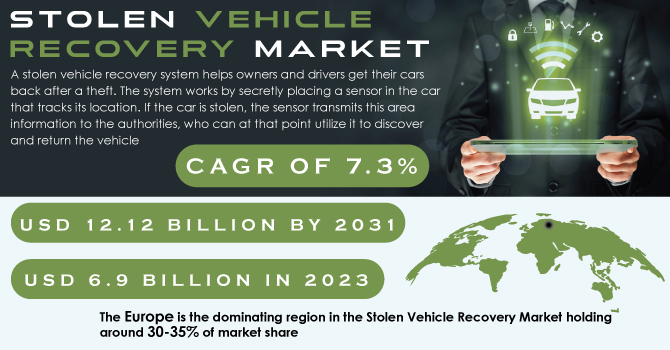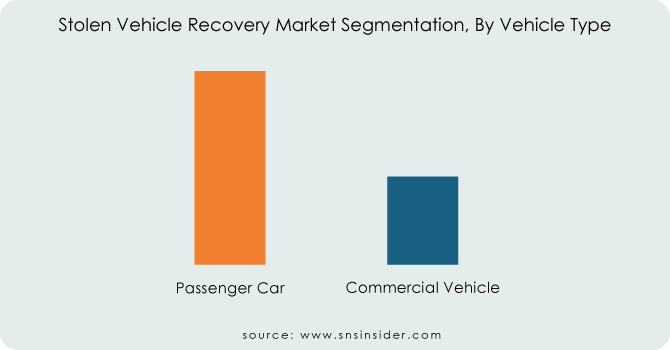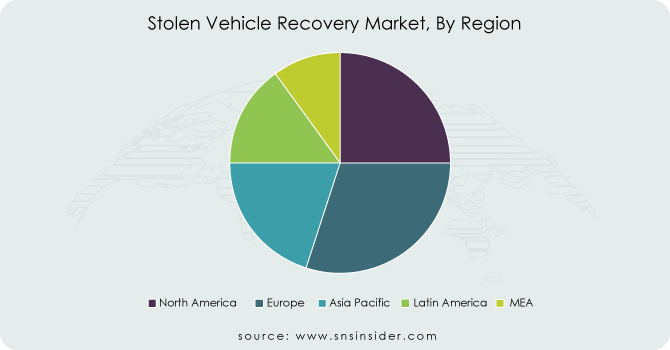Stolen Vehicle Recovery Market Report Scope & Overview:
The Stolen Vehicle Recovery Market Size was valued at USD 6.9 billion in 2023 and is expected to reach USD 12.12 billion by 2031 and grow at a CAGR of 7.3% over the forecast period 2024-2031.
A stolen vehicle recovery system helps owners and drivers get their cars back after a theft. The system works by secretly placing a sensor in the car that tracks its location. If the car is stolen, the sensor transmits this area information to the authorities, who can at that point utilize it to discover and return the vehicle. This innovation is getting to be progressively well known due to a rise in car thefts, particularly of luxury vehicles. Criminals are creating more progressed methods to steal cars, including hacking into their computer systems. This is particularly hazardous risky with cars that have keyless entry, which can be vulnerable to unauthorized access. To combat these robberies, major car manufacturers are joining anti-theft systems into their vehicles, making stolen vehicle recovery systems a valuable tool for car owners.

Get More Information on Stolen Vehicle Recovery Market - Request Sample Report
MARKET DYNAMICS:
KEY DRIVERS:
-
Insurance Companies Drive Demand for Stolen Vehicle Recovery Systems by Mandating Their Use for Lower Premiums
-
Rising Vehicle Theft Rates Drive Demand for Advanced Tracking and Recovery Systems
The growing number of car thefts globally is driving the demand for both advanced vehicles tracking systems and stolen vehicle recovery solutions. As car theft gets to be more common, particularly for luxury vehicles, individuals are progressively looking for ways to track their cars and improve the chances of getting them back. This rise in theft, coupled with the developing advancement of criminals, is making a strong market for stolen vehicle recovery systems that depend on advanced tracking technology.
RESTRAINTS:
-
Data Security Concerns May Hinder Long-Term Growth of Stolen Vehicle Recovery Market
The future of stolen vehicle recovery systems might be clouded by protection concerns. These systems collects the lot of information about a vehicle's location and potentially even the driver. Individuals are stressed that this data might be hacked or misused, which might discourage them from installing these systems in the long run. This raises a challenge for the industry by adjusting the benefits of stolen vehicle recovery with vigorous data security measures to ensure consumer trust.
OPPORTUNITIES:
-
Increasing car thefts, particularly of luxury vehicles, create a strong demand for recovery solutions.
-
Improved GPS and location tracking tools enhance stolen vehicle recovery efficiency.
CHALLENGES:
-
Equipping vehicles with advanced recovery systems can be expensive for both manufacturers and consumers.
-
Criminals may use signal jammers to disrupt communication between stolen vehicles and tracking devices.
IMPACT OF RUSSIA-UKRAINE WAR
The war in Russia-Ukraine has disrupted the stolen vehicle recovery market by potentially impacting its growth by around 5-10%. The supply chain disruptions caused by the conflict have limited the production of essential components for stolen vehicle recovery systems. Shortages in semiconductors and other electronic parts used in tracking devices and communication systems could lead to delays in vehicle equipment and installation. This can create a bottleneck, delaying market expansion. The war has diverted resources and attention away from non-essential sectors like stolen vehicle recovery. Governments and law enforcement agencies in some regions may prioritize defence spending and border security, potentially leading to a decrease in funding allocated towards stolen vehicle recovery initiatives. This could slow down the adoption of these systems, particularly in war-torn areas or neighbouring countries directly affected by the conflict.
IMPACT OF ECONOMIC SLOWDOWN
An economic slowdown can potentially hinder the growth of the stolen vehicle recovery market in a few ways. During economic downturns, consumers tend to tighten their budgets and prioritize essential spending over discretionary purchases This could lead to a 5-10% decline in new car sales, which translates to fewer vehicles equipped with factory-installed stolen vehicle recovery systems. The budget cuts for law enforcement agencies during economic downturns could lead to a reduction of 2-5% in resources dedicated to stolen vehicle recovery efforts. This could slightly decrease the effectiveness of these systems, impacting their perceived value for some consumers. Thus, economic hardship might force some individuals to delay the installation of aftermarket stolen vehicle recovery systems in their existing cars. This could cause a 3-7% decline in aftermarket system sales.
KEY MARKET SEGMENTS:
By Technology
-
Ultrasonic
-
Radio Frequency Identification
-
Others
Radio Frequency Identification (RFID) is the dominating sub-segment in the Stolen Vehicle Recovery Market by technology holding around 42% of market share. RFID technology offers long-range detection capabilities, making it perfect for tracking stolen vehicles indeed when they're hidden in remote locations. Also, RFID labels are tamper-proof and moderately cheap, making them a popular choice for both producers and customers.
By Component
-
Ultrasonic Intruder Protection System (UIP)
-
Backup Battery Siren (BBS)
-
Central Locking System
-
Automatic Collision Detection System
-
Automatic Driver Recognition System (ADRS)
-
Remote Keyless Entry System
-
Others
The remote keyless entry system is the dominating sub-segment in the Stolen Vehicle Recovery Market by component holding around 35-45% of market share due to its increasing popularity in modern vehicles. This system allows keyless entry and ignition through a fob or smartphone app, offering convenience to users. However, it can also create vulnerabilities if not equipped with robust security features. The growing demand for feature-rich cars and rising theft attempts targeting these systems are driving the RKES segment's dominance.
By Vehicle Type
-
Passenger Car
-
Commercial Vehicle
Passenger Cars is the dominating sub-segment in the Stolen Vehicle Recovery Market by vehicle type holding around 72% of market share. Passenger cars represent a larger market share compared to commercial vehicles. Additionally, luxury and high-performance passenger cars are often targeted by thieves, driving the demand for advanced stolen vehicle recovery systems in this segment.

Get Customized Report as per your Business Requirement - Ask For Customized Report
By Sales Channel
-
OEM
-
Aftermarket
Original Equipment Manufacturer is the dominating sub-segment in the Stolen Vehicle Recovery Market by sales channel holding around 60% of market share. A growing number of car manufacturers are integrating stolen vehicle recovery systems as standard features or offering them as factory-installed options. This trend is driven by consumer demand for enhanced security and the rising number of car thefts.
REGIONAL ANALYSES
The Europe is the dominating region in the Stolen Vehicle Recovery Market holding around 30-35% of market share due to factors like mandatory advanced security features in vehicles, a strong automotive industry fostering innovation, and high theft rates in some countries.
North America is the second largest region in this market holding 25-30% of share with a large car-owning population, rising theft-related insurance costs pushing for recovery solutions, and government initiatives promoting car security.
The Asia-Pacific is the fastest-growing region with 20-25% of market share due to economic growth boosting car ownership, increasing urbanization creating demand for advanced recovery systems, and rising theft rates coupled with less stringent regulations compared to other regions.

REGIONAL COVERAGE:
North America
-
US
-
Canada
-
Mexico
Europe
-
Eastern Europe
-
Poland
-
Romania
-
Hungary
-
Turkey
-
Rest of Eastern Europe
-
-
Western Europe
-
Germany
-
France
-
UK
-
Italy
-
Spain
-
Netherlands
-
Switzerland
-
Austria
-
Rest of Western Europe
-
Asia Pacific
-
China
-
India
-
Japan
-
South Korea
-
Vietnam
-
Singapore
-
Australia
-
Rest of Asia Pacific
Middle East & Africa
-
Middle East
-
UAE
-
Egypt
-
Saudi Arabia
-
Qatar
-
Rest of the Middle East
-
-
Africa
-
Nigeria
-
South Africa
-
Rest of Africa
-
Latin America
-
Brazil
-
Argentina
-
Colombia
-
Rest of Latin America
KEY PLAYERS
The major key players are Denso Corporation (Japan), Robert Bosch GmbH (Germany), HELLA GmbH & Co. KGaA (Germany), Valeo (France), Mitsubishi Electric Corporation (Japan), Continental AG (Germany), Lear Corporation (US), CalAmp, Tokairika, Co, Ltd (Japan), OMRON Corporation (Japan) and other key players
Denso Corporation (Japan)-Company Financial Analysis

RECENT DEVELOPMENTS:
-
In Sept. 2023: The UK's Stolen Vehicle Intelligence Unit achieved success in recovering high-value stolen vehicles. Acting on intelligence, the unit intercepted two shipping containers packed with stolen cars, bringing their total recovered haul to 60 containers of stolen vehicles and parts.
-
In March 2023: The Denver Police Department launched "DenverTrack," a program to combat auto theft. It aims to expedite stolen vehicle recovery, facilitate arrests of perpetrators, and deter theft altogether.
-
In March 2023: In response to rising auto theft rates in Canada, Ontario insurance providers are offering anti-theft technology. Aviva Insurance leads the charge by partnering with Tag, a North American vehicle tracking and recovery system.
| Report Attributes | Details |
|---|---|
| Market Size in 2023 | US$ 6.9 Billion |
| Market Size by 2031 | US$ 12.12 Billion |
| CAGR | CAGR of 7.3% From 2023 to 2030 |
| Base Year | 2023 |
| Forecast Period | 2024-2031 |
| Historical Data | 2020-2022 |
| Report Scope & Coverage | Market Size, Segments Analysis, Competitive Landscape, Regional Analysis, DROC & SWOT Analysis, Forecast Outlook |
| Key Segments | • By Technology (Ultrasonic, Radio Frequency Identification, Others) • By Component (Ultrasonic Intruder Protection System, Backup Battery Siren, Central Locking System, Automatic Collision Detection System, Automatic Driver Recognition System, Remote Keyless Entry System, Others) • By Vehicle Type (Passenger Car, Commercial Vehicle) • By Sales Channel (OEM, Aftermarket) |
| Regional Analysis/Coverage | North America (US, Canada, Mexico), Europe (Eastern Europe [Poland, Romania, Hungary, Turkey, Rest of Eastern Europe] Western Europe] Germany, France, UK, Italy, Spain, Netherlands, Switzerland, Austria, Rest of Western Europe]), Asia Pacific (China, India, Japan, South Korea, Vietnam, Singapore, Australia, Rest of Asia Pacific), Middle East & Africa (Middle East [UAE, Egypt, Saudi Arabia, Qatar, Rest of Middle East], Africa [Nigeria, South Africa, Rest of Africa], Latin America (Brazil, Argentina, Colombia, Rest of Latin America) |
| Company Profiles | Denso Corporation (Japan), Robert Bosch GmbH (Germany), HELLA GmbH & Co. KGaA (Germany), Valeo (France), Mitsubishi Electric Corporation (Japan), Continental AG (Germany), Lear Corporation (US), CalAmp, Tokairika, Co, Ltd (Japan), OMRON Corporation (Japan) |
| Key Drivers | • Insurance Companies Drive Demand for Stolen Vehicle Recovery Systems by Mandating Their Use for Lower Premiums • Rising Vehicle Theft Rates Drive Demand for Advanced Tracking and Recovery Systems |
| RESTRAINTS | • Data Security Concerns May Hinder Long-Term Growth of Stolen Vehicle Recovery Market |

